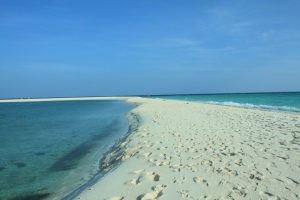
Example of a Sandbar Landform:
Miami Beach
A sandbar is an area of sand, gravel or fine sediment that sits above the water. It may be connected to the shoreline, or it may be offshore. It is generally narrow and straight. A sandbar is also known as a shoal or sandbank. A large sandbar is called a barrier island.
Sandbars begin forming underwater. As waves break, this pulls material from the shoreline, migrating further into the ocean. During heavy storms, large waves can build sandbars far from shore, until they rise above the water’s surface.
When waves are large, sand, gravel and other sediment can gather underwater in large amounts. This can block channels and prevent ships and boats from passing. During a storm, this can cause a ship to become stranded on the sandbar and perhaps destroyed.
Continuous wave action and storms can build a sandbar until it becomes a barrier island. The way that a barrier island forms is not fully understood, and many theories have been given. Barrier islands are long, narrow and straight. One example of this is Miami Beach, Florida. It lies on a barrier island that was created by wave action and storms over many thousands of years. Barrier islands provide protection for the channel and the mainland shore behind.
Barrier islands can flood easily during storms and especially during hurricanes. Heavy damage can occur from rushing water and high winds. Bolivar Island on the coast of Texas was nearly destroyed by Hurricane Ike in 2008. Many homes were lost and 15 people were killed.
Famous Sandbars (Barrier Islands)
The waters behind sand bars and barrier islands can form tidal pools, lagoons, salt marshes and other wetlands. A variety of marine life can grow in these areas. They can harbor seaweed, algae and other marine vegetation. They are homes for a variety of fish and shellfish. These wetlands can also attract a variety of birds and other wildlife.
An area of sand, gravel or fine sediment that sits above the water
Related to Sandbars: Barrier Islands
We want pictures and location of the lanforms around the world and we need your help. Click get started button below.
In Asia, China, India, Nepal, and Bhutan are home to one of the eight wonders of the world and one of the most beautiful mountains in the world, the Himalaya Mountains also called the Himalayas. Boasting as the world’s highest and most famous mountain peak, Mt. Everest. Within the verse of the ‘Kumarsambhava’, Sanskrit […]
Nature have provided us with fascinating landforms and features. The most often adored landforms are volcanoes. Like the perfect cone structure of Mayon Volcano in the Philippines or Mount Fiji in Japan, people look at their beauty and wonder with great appreciation to nature. Volcanoes are mountains with a very disastrous nature. Their only […]
Taal Volcano is the second most active volcano found in the province of Batangas. A complex volcano in the middle of Taal Lake and is often called an island within a lake, that is an island within a lake that is on an island as well as one of the lowest volcano in the […]
Mayon Volcano is one of the active volcanoes in the Philippines. Located in the southern part of Luzon about 473 kilometers (294 miles) from Makati Business District of the Philippines, Mount Mayon is the main landmark of the Province of Albay of Bicol Region. According to local folklore, the volcano was named after Daragang […]
The global temperature and weather is to a large extent a direct result of the sun’s effect to our planet. Together with the atmosphere and the rotation of the earth on its axis. The earth on which weather moves on has its own effect on the weather. The different landforms like mountains, volcanoes, plains, and the […]